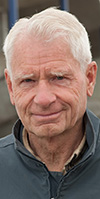|
Subscribe / Renew |
|
|
Contact Us |
|
| ► Subscribe to our Free Weekly Newsletter | |
| home | Welcome, sign in or click here to subscribe. | login |
Architecture & Engineering
| |
August 30, 2017
Jack Christiansen's designs were ‘grand scale' sculpture
John V. (Jack) Christiansen, a pioneer in designing thin shell concrete structures, died Aug. 16 on Bainbridge Island. He was 89.
Christiansen worked as a structural engineer in Seattle and was celebrated worldwide for his designs, according to associates and information from Tyler Sprague, a structural engineer and University of Washington professor who has written a book about Christiansen's life and career.

He was structural engineer for the Kingdome, which was the largest concrete dome in the world, and for the Pacific Science Center at Seattle Center. His firm also worked on the World Trade Center in New York City.
Christiansen worked at what is now Seattle-based Magnusson Klemencic Associates from 1952 until his retirement on Jan. 1, 1983.
Jon Magnusson, senior principal of MKA, called him one of the most creative engineers he ever met.
“When he worked with trace paper and a soft pencil on structural concepts, he actually created art,” Magnusson said. “He set the example for the whole firm of how structure could, and should, be architecture. His love and talent for architecture became embedded in the DNA of our firm and lives on to this day.”
Christiansen's signature Northwest projects include Montlake Pedestrian Bridges (1958), Exhibition Hall (now Pacific Northwest Ballet) with Paul Kirk (1962), the U.S. Pavilion at Spokane Expo 74 with NBBJ (1974), and the Museum of Flight with Ibsen Nelson (1983).
He worked with architect Minoru Yamasaki to design the delicate concrete structures and towers for what is now Pacific Science Center for the 1962 Seattle World's Fair. That project is often credited with helping Yamasaki win the World Trade Center commission.
Christiansen collaborated with many Northwest architects including Paul Kirk, Fred Bassetti and the early partners of NBBJ, but he explored the expressive forms of thin shell concrete structures in his own way, believing that the structure of a building should be a noticeable part of its overall design.
Sprague said that after starting with simple barrel-vaulted forms, he was inspired by the Mexican builder Felix Candela to try more complex, doubly-curved shell geometries.
Christiansen realized over 75 thin shell concrete structures, Sprague said, making him one of the most prolific thin shell concrete designers in the world.
Bill Bain Jr., former partner at NBBJ, said Christiansen's thin shell concrete designs were truly elegant. “He is someone we will never forget.”
Christiansen was born on Sept. 28, 1927 in Chicago. He studied architectural engineering at the University of Illinois, Champagne-Urbana, graduating in 1949 with a bachelor's degree. He attended Northwestern University, and got a master's in structural engineering in 1950, before working in Chicago for Perkins and Will, and Shaw Metz and Dolio.
Christiansen moved to the Northwest in 1952, and joined the consulting engineering firm W. H. Witt in Seattle.
The firm, which became Skilling, Helle, Christiansen Robertson in 1967, rose to international prominence with the structural design of the World Trade Center Towers. The firm continues today as Magnusson Klemencic Associates.
Sprague said Christiansen pushed thin shell concrete structures to larger scales. In 1968, he worked with the New Orleans architects Curtis and Davis to design Rivergate Exhibition Hall along the Mississippi River.
Christiansen compared the Kingdome to the Roman Coliseum, and believed it could last over 1,000 years. Friends said Christiansen was devastated when the structure was imploded in 2000 due to changing demands for sports facilities.
Christiansen said he loved being an engineer because “It's like you are creating sculpture on a grand scale.”
After retiring, Christiansen taught at the University of Washington and worked as a consultant.
He was elected into the National Academy of Engineering in 1987, and awarded the Eduardo Torroja Medal by the International Association of Shell and Spatial Structures in 2016.
Christiansen also was a mountaineer, climbing mountains all over the world as well as over 100 peaks in the Olympic Range.
He was preceded in death by his wife, Sue, in 2010, and is survived by his children: Karin Kajita, Robert Christiansen, Nelda Swiggett, Janet Jorgenson and John Christiansen.



